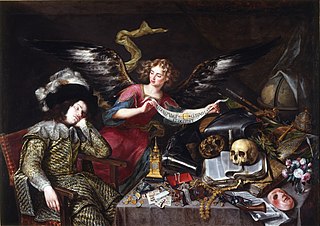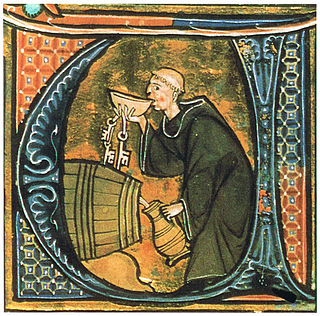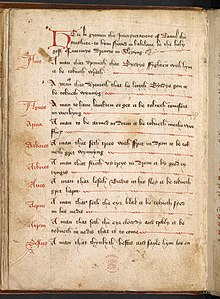
Beowulf is an Old English epic poem consisting of 3,182 alliterative lines. It is one of the most important works of Old English literature. The date of composition is a matter of contention among scholars; the only certain dating pertains to the manuscript, which was produced between 975 and 1025. The author was an anonymous Anglo-Saxon poet, referred to by scholars as the "Beowulf poet".

Palaeography (UK) or paleography is the study of ancient and historical handwriting. Included in the discipline is the practice of deciphering, reading, and dating historical manuscripts, and the cultural context of writing, including the methods with which writing and books were produced, and the history of scriptoria.

Umberto Eco was an Italian novelist, literary critic, philosopher, semiotician, and university professor. He is widely known for his 1980 novel Il nome della rosa, a historical mystery combining semiotics in fiction with biblical analysis, medieval studies, and literary theory. He later wrote other novels, including Il pendolo di Foucault and L'isola del giorno prima. His novel Il cimitero di Praga, released in 2010, topped the bestseller charts in Italy.

The Vulgate is a late-4th-century Latin translation of the Bible that became the Catholic Church's officially promulgated Latin version of the Bible during the 16th century. The translation was largely the work of Jerome, who in 382 had been commissioned by Pope Damasus I to revise the Vetus Latina Gospels then in use by the Roman Church. Jerome, on his own initiative, extended this work of revision and translation to include most of the books of the Bible, and once published, the new version was widely adopted and eventually eclipsed the Vetus Latina; so that by the 13th century, it had taken over from the former version the appellation of versio vulgata or vulgata for short, and in Greek as βουλγάτα ("Voulgata").

A dream is a succession of images, ideas, emotions, and sensations that usually occur involuntarily in the mind during certain stages of sleep. The content and purpose of dreams are not fully understood, although they have been a topic of scientific, philosophical and religious interest throughout recorded history. Dream interpretation is the attempt at drawing meaning from dreams and searching for an underlying message. The scientific study of dreams is called oneirology.

The Voynich manuscript is an illustrated codex hand-written in an unknown writing system. The vellum on which it is written has been carbon-dated to the early 15th century (1404–1438), and it may have been composed in Italy during the Italian Renaissance. The manuscript is named after Wilfrid Voynich, a Polish-Samogitian book dealer who purchased it in 1912.
Hermeneutics is the theory and methodology of interpretation, especially the interpretation of biblical texts, wisdom literature, and philosophical texts.

The Mabinogion are the earliest prose stories of the literature of Britain. The stories were compiled in Middle Welsh in the 12th–13th centuries from earlier oral traditions. The two main source manuscripts were created c. 1350–1410, as well as a few earlier fragments. These stories offer drama, philosophy, romance, tragedy, fantasy and humour, and were created by various narrators over time. The title covers a collection of eleven prose stories of widely different types. There is a classic hero quest, "Culhwch and Olwen"; historic legend in "Lludd and Llefelys," complete with glimpses of a far off age; and other tales portray a very different King Arthur from the later popular versions. The highly sophisticated complexity of the Four Branches of the Mabinogi defies categorisation. The stories are so diverse that it has been argued that they are not even a true collection.

The Archpoet, or Archipoeta, is the name given to an anonymous 12th-century author of ten medieval Latin poems, the most famous being his "Confession" found in the Carmina Burana manuscript. Along with Hugh Primas of Orléans, he is cited as the best exemplar of Goliardic poetry and one of the stellar poets of the Latin Middle Ages.

Porphyry of Tyre was a Neoplatonic philosopher who was born in Tyre, in the Roman Empire. He edited and published the Enneads, the only collection of the work of his teacher Plotinus. His commentary on Euclid's Elements was used as a source by Pappus of Alexandria.
Oneiromancy is a form of divination based upon dreams; it is a system of dream interpretation that uses dreams to predict the future.
Artemidorus Daldianus or Ephesius was a professional diviner who lived in the 2nd century AD. He is known from an extant five-volume Greek work, the Oneirocritica or Oneirokritikon.
The Sortes Astrampsychi was a popular Greco-Roman fortune-telling guide ascribed to Astrampsychus, identified by ancient authors as a magus who lived in Persia before the conquest of Alexander the Great, or an Egyptian sage serving a Ptolemaic king. While other sortes involved the casting of dice, the Sortes Astrampsychi did not. Instead, a questioner chose a prewritten question, to which a number was assigned; calling on divine inspiration, the questioner then spoke a number from one to ten, which was added to the question number; the oracle-monger then provided one of ten possible replies by consulting a numerical index. The text is known from thirteen papyrus fragments of the third to sixth centuries CE, and from Byzantine manuscripts which date from the fourteenth to sixteenth centuries but are completely preserved. The Byzantine texts add Christian religious elements.

Watcher is a term used in connection with biblical angels. Watcher occurs in both plural and singular forms in the Book of Daniel, where reference is made to their holiness. The apocryphal Books of Enoch refer to both good and bad Watchers, with a primary focus on the rebellious ones.
African literature is literature of or from Africa and includes oral literature.
Foebus abierat is a medieval Latin poem, authorship unknown, composed near the end of the 10th century in Northern Italy. Described as "hauntingly beautiful" and "one of the joys of medieval poetry," it is an erotic dream-vision lyric spoken by a woman who grieves the departure of her lover Phoebus, brother of the Moon. Although the language is ecclesiastical Latin, none of its content is explicitly Christian.
Divine madness, also known as theia mania and crazy wisdom, refers to unconventional, outrageous, unexpected, or unpredictable behavior linked to religious or spiritual pursuits. Examples of divine madness can be found in Hellenism, Christianity, Hinduism, Buddhism, Sufism, and Shamanism.
Durant Waite Robertson Jr. was a scholar of medieval English literature and especially Geoffrey Chaucer. He taught at Princeton University from 1946 until his retirement in 1980 as the Murray Professor of English, and was "widely regarded as this [the twentieth] century's most influential Chaucer scholar".
Annowre (Anouwre) is an evil enchantress who desires King Arthur in Thomas Malory's Le Morte d' Arthur. Malory based her on a character from the earlier Prose Tristan, who was named as Elergia in the Italian La Tavola Ritonda.
Valerio, Cappozzo. 2018. Dizionario dei sogni nel Medioevo. Il Somniale Danielis in manoscritti letterari [The Medieval Dream Dictionary. The Somniale Danielis in Literary Manuscripts]. Biblioteca dell'«Archivum Romanicum» - Serie I: Storia, Letteratura, Paleografia. Florence: Leo S. Olschki. https://en.olschki.it/libro/9788822264954

















